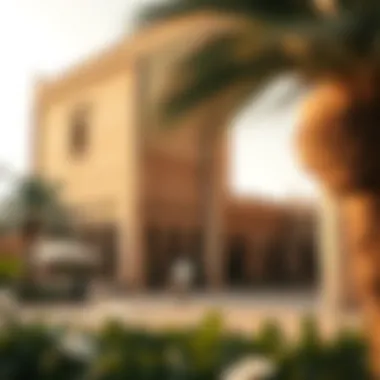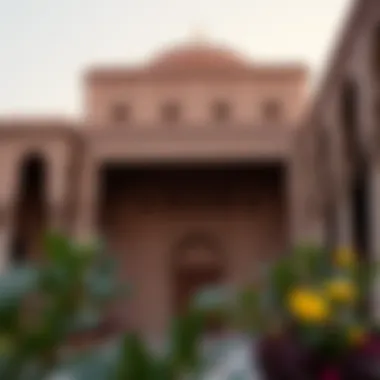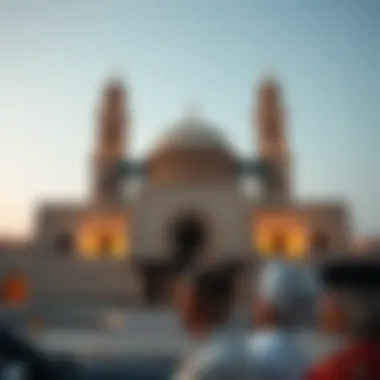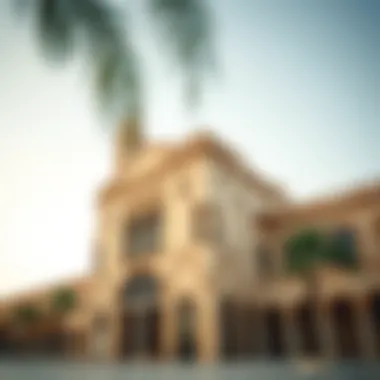Exploring Qasr Al Qasimia: Dubai's Architectural Gem


Market Insights
Understanding the real estate landscape in Dubai requires a keen eye on current trends. The market is dynamic and ever-evolving, reflecting both local and international influences.
Current Trends in Dubai Real Estate
In recent years, Dubai has seen a surge in luxury developments, particularly around historically significant areas such as Qasr Al Qasimia. This growth is fueled by a blend of factors, including rising expatriate populations and a robust tourism industry. Investors now exhibit a keen interest in properties that combine heritage with modern amenities.
- Luxury Living: Properties near Qasr Al Qasimia are selling like hot cakes, often attracting high-net-worth individuals looking for both a home and an investment.
- Cultural Significance: As a monument, Qasr Al Qasimia has become a focal point. Its proximity to real estate options adds a layer of desirability for potential buyers.
- Sustainability Trends: New projects are increasingly taking a sustainable approach. Developers are using eco-friendly materials and practices, which add value to the properties and attract environmentally conscious buyers.
Key Factors Influencing Property Prices
Several elements impact property prices in this bustling market.
- Location: Properties that are close to Qasr Al Qasimia and public transport often command higher prices. The cultural significance of the location plays a role.
- Amenities and Facilities: Properties offering modern amenities such as gyms, pools, and retail spaces see a buoyant demand. Buyers are looking for homes that provide a full lifestyle experience.
- Market Regulations: Changes in regulatory policies can impact pricing. Keeping an eye on government announcements regarding property laws is essential for investors.
"Continued growth in investment in historic properties, like those surrounding Qasr Al Qasimia, illustrates a broader trend towards buying for both resident enjoyment and investment potential."
Investment Opportunities
Diving into the property market surrounding Qasr Al Qasimia opens several pathways for potential investments.
Best Areas for Property Investment
Investors would be remiss not to consider areas that complement the rich heritage of Qasr Al Qasimia.
- Al Majaz: Known for its waterfront developments, this area attracts both families and young professionals.
- Al Shahba: With its proximity to educational institutions, Al Shahba is ideal for families looking for long-term investments.
- Government Areas: Areas where government buildings are situated often see an increase in property values over time, making them a wise choice for investment.
Legal Considerations for Foreign Investors
Investing in Dubai’s real estate as a foreigner comes with its own set of rules. It’s crucial for potential buyers to be aware of the legal landscape.
- Ownership Laws: Understanding freehold vs leasehold properties is essential. Foreigners can buy in designated areas but should research these limits.
- Financing Options: Many banks offer attractive mortgage solutions for foreigners, but terms can vary. Thorough research is necessary.
- Fees and Taxes: Buyers should factor in various charges like registration fees and property taxes. Being prepared will help avoid unexpected costs down the road.
Historical Context of Qasr Al Qasimia
Understanding the historical context of Qasr Al Qasimia is imperative for grasping its multifaceted role within Dubai's architectural tapestry. This landmark, far more than just a building, serves as a testament to the evolution of Emirati identity and the broader narrative of Dubai itself. Unpacking its origins, architectural shifts, and cultural relevance reveals layers of significance that resonate with both locals and visitors, helping to contextualize its place within the ever-changing urban landscape.
The Origins of Qasr Al Qasimia
Qasr Al Qasimia's origins are steeped in the rich soil of Emirati history. Erected in the 20th century, its foundation is a reflection of the aspirations of its time. The building was commissioned during a period when Dubai was transitioning from a modest trading port to a bustling metropolis. Originally intended as the official residence for the ruling family, it bears witness to the quickening pace of development in the region.
What’s fascinating is how the design infused traditional Emirati elements with modern influences. This melding of styles pushed boundaries and, in a way, set a precedent for future developments in the emirate. Visitors often find themselves admiring the intricate mashrabiya and grand courtrooms that are a nod to regional architecture, interwoven with updates that signal an eye towards the future.
Architectural Evolution Through the Years
Peering through the corridors of time, we see Qasr Al Qasimia adapting to the needs of each era. Initially, it was a bastion of tradition, featuring ornate decorations and spacious courtyards that reflected a lifestyle of hospitality and governance. As Dubai burgeoned, so too did the castle, undergoing renovations to accommodate modern governance and cater to an increasingly international audience.
The architectural evolution has been characterized by a shift that marries functionality with aesthetic beauty. The internal spaces have been reconfigured, enhancing the experience for both dignitaries and common folk alike. Every corner, every stone seems to tell stories of adaptation - from hosting formal gatherings to welcoming visitors eager to explore its splendor.
Cultural Significance in Emirati Heritage
Qasr Al Qasimia is not just a building; it's a cultural keystone in the Emirati heritage narrative. It stands as a symbol of unity, governance, and the cultural exchange that defines Dubai. The palace has hosted various events, including international delegations and cultural festivals that bring together local and global communities.
The significance of Qasr Al Qasimia extends into the realms of education and cultural preservation. Schools often organize trips to showcase the emirate's rich history. In many ways, it serves as a classroom outside the traditional brick-and-mortar educational settings. The residents of Dubai take pride in it, as it embodies their collective history and aspirations.


Architectural Features of Qasr Al Qasimia
The architectural landscape of Qasr Al Qasimia stands as a testament to both cultural heritage and innovative design. Situated in the heart of Sharjah, this structure reflects the royal lineage of the Al Qasimi family while intertwining modern functionality with traditional aesthetics. The architectural features provide invaluable insights into not just the history of the structure but also its role in shaping the local community and real estate market.
Design Elements and Aesthetic Appeal
Upon first glance, the elegance of Qasr Al Qasimia captures one’s attention. The design elements resonate with a distinctive Arabic architecture style that challenges the ocean's shores while blending harmoniously with the surrounding landscape. Key features include grand arches, intricate ornate calligraphy, and expansive domes that rise majestically.
A closer examination reveals the usage of symmetry and proportion, pivotal in Islamic architecture, enhancing the palace's spiritual ambiance. The interior spaces are adorned with elaborate stucco details and vivid colors, creating a contrasting yet complementary palette against the natural shades of the surrounding environment. Moreover, the gardens that embellish the exterior serve not only as a recreational space but also as a serene backdrop, inviting visitors to pause and appreciate the beauty.
In terms of aesthetic appeal, Qasr Al Qasimia captivates visitors with its visual storytelling, drawing them into the history embedded within its walls. Such features are not mere decoration; they encapsulate a rich heritage that holds significance for the Emirati people.
Material and Craftsmanship
The materials employed in building Qasr Al Qasimia add another layer of depth to its architectural story. Predominantly, local stones and sand are utilized, emblematic of traditional Emirati building methods. This not only showcases the craftsmanship involved but also emphasizes sustainability, utilizing what the environment offers.
Artisans from the region played a crucial role, employing age-old techniques of plastering and tiling. Intricate mosaics and handcrafted woodwork can be witnessed through the palace, embodying the skills passed down from generation to generation. For instance, the wooden ceilings are meticulously carved and reflect a stunning interplay of light and shadow throughout the day.
Another remarkable aspect is the integration of modern materials, which has been done tastefully. The use of reinforced concrete has helped preserve the structure while maintaining its physical integrity, proving that the past and the future can coexist.
Comparative Analysis with Other Architectural Styles
When we place Qasr Al Qasimia side by side with other architectural masterpieces in the Emirates, distinct differences and similarities emerge. The blend of traditional Islamic motifs with Modernist elements in Qasr Al Qasimia sets it apart from structures like the Burj Khalifa, which embraces a more contemporary, skyscraper aesthetic.
In comparison to traditional castles or forts in the region, such as Al Jahili Fort, Qasr Al Qasimia offers a more refined and open environment, facilitating both social gatherings and state functions.
This palace also signifies a departure from merely utilitarian purposes that characterize many historic buildings; it reflects an evolution towards structures that accommodate contemporary civic functions.
"Qasr Al Qasimia reminds us that architecture is not just about buildings; it’s about how these structures contribute to community and identity.”
Furthermore, the modern lines and public accessibility of Qasr Al Qasimia resonate with the growing trend towards inclusivity in contemporary architecture, making it a relevant study for investors and enthusiasts alike, who find value in both heritage and usability.
In essence, the architectural features of Qasr Al Qasimia are not only aesthetically pleasing but also represent a crucial blend of heritage and progress that locals and visitors alike cherish.
The Role of Qasr Al Qasimia in Modern Dubai
The significance of Qasr Al Qasimia in the context of contemporary Dubai is multi-faceted. It serves not only as a historical landmark, but also as a vibrant hub for civic activities and cultural events that engage the local community. By integrating traditional Emirati heritage with the city’s rapid modern growth, Qasr Al Qasimia stands as a bridge between the past and the future.
Civic Functions and Community Engagement
Qasr Al Qasimia plays a crucial role in civic life in Dubai. It often hosts events that foster a sense of community and encourage public participation. From governmental ceremonies to cultural festivals, the palace is a venue where residents come together to celebrate their identity and heritage. This engagement goes beyond festive gatherings.
Community workshops and educational programs are held regularly, focusing on preserving Emirati traditions and educating younger generations about their history. Such initiatives not only enhance civic pride but also provide valuable opportunities for local artists and craftsmen to showcase their talents.
Moreover, Qasr Al Qasimia's location facilitates easy access for residents in neighboring communities, promoting inclusivity and participation across diverse segments of the city's population. This palace isn’t just a building; it embodies the spirit of Dubai, emphasizing the importance of togetherness in a rapidly changing urban environment.
Impact on Local Tourism and Economy
In terms of economic impact, Qasr Al Qasimia serves as an anchor point for tourism in Dubai. The majestic architecture and its storied past attract both local and international visitors, which, in turn, boosts local businesses. Tourists flock to the area, leading to increased foot traffic in nearby shops, restaurants, and hotels.
According to estimates, the influx of visitors during cultural events can increase local revenues significantly, spurring further investments in the tourism sector.
A few key highlights regarding the economic impact include:
- Increased hotel bookings: The proximity of Qasr Al Qasimia to various accommodations means that tourists spend nights in hotels around the vicinity.
- Boost in local artisanship: The palace's emphasis on culture supports local craftsmen who create goods reflective of Emirati tradition, enhancing the local economy.
- Dining and entertainment: Restaurants and cafes near the palace thrive as they attract hungry tourists looking to experience local cuisine.


"Tourism is not simply about bringing people in; it’s about creating experiences that enhance the local economy and bolster community pride."
Integration with Urban Development Plans
Looking ahead, Qasr Al Qasimia is outlined as a pivotal element in Dubai's comprehensive urban development strategies. Urban planners recognize that blending new infrastructure with historical sites is vital in maintaining the city's identity while accommodating growth.
Designs to enhance the area's accessibility, including expanded public transport routes and pedestrian-friendly zones, aim to integrate the palace into the broader urban landscape. This strategic approach ensures that as Dubai modernizes, its cultural landmarks are preserved and celebrated, allowing them to coexist harmoniously with skyscrapers and innovation hubs.
Key areas of focus include:
- Sustainability initiatives: Efforts to use renewable energy sources within the palace complex to align with Dubai's vision for a greener future.
- Urban green spaces: Plans to create parks and recreational areas around Qasr Al Qasimia, enhancing the livability of the urban environment.
- Smart technology integration: Adoption of smart city technologies to enhance visitor experience while preserving the historic character of the site.
Through these initiatives, Qasr Al Qasimia is not just seen as a relic of the past; it is a living part of the city's narrative, contributing to both cultural continuity and modern innovation.
Investment Opportunities near Qasr Al Qasimia
The area surrounding Qasr Al Qasimia is brimming with potential investment opportunities, making it a focal point for investors looking to capitalize on Dubai’s ever-evolving real estate market. This section scrutinizes the various factors making such investments appealing, including market dynamics, demand trends, and unique advantages the location offers. For those in the know, understanding these elements could pave the way for fruitful ventures.
Real Estate Trends in Surrounding Areas
To get a true grip on the investment climate surrounding Qasr Al Qasimia, it's crucial to analyze the prevailing real estate trends. Over the last few years, there has been an observable spike in both commercial and residential developments in the vicinity. New skyscrapers and complexes adorn the skyline, and with projects like the Al Qasimia Development Plan rolling out, there’s no sign of slowing down.
- Increased Demand: The growing population and influx of expatriates have spurred higher demand for housing.
- Diverse Offerings: From luxury apartments to affordable housing, there are various options catering to different market segments.
- Infrastructure Investments: Significant governmental investments in transportation and public amenities are enhancing accessibility, further boosting property value.
These trends suggest that individuals looking to invest near Qasr Al Qasimia stand to gain from future appreciation in property values.
Commercial vs. Residential Investment Options
When it comes to investment choices near Qasr Al Qasimia, one is often torn between commercial and residential options. Each type has its own set of benefits and considerations that an investor must weigh carefully.
Residential Investment
Investing in residential properties often equates to steady rental income.
- High Demand: With an ever-growing population, securing a residential unit can provide stable returns.
- Long-term Security: Most individuals prefer to rent near their workplaces, especially areas like Qasr Al Qasimia which is conveniently located.
Commercial Investment
On the flip side, commercial properties may offer larger returns but could also pose higher risks.
- Higher Rental Yields: Businesses tend to pay more rent compared to residential tenants.
- Business Growth: Many new businesses are sprouting in the area, thanks to an influx of residents and tourists.
Ultimately, the decision comes down to individual risk tolerance and investment strategy.
Long-term Growth Projections
The long-term growth projections for areas around Qasr Al Qasimia appear promising, influenced by multiple factors:
- Economic Diversification: Dubai’s ongoing efforts to diversify its economy beyond oil are fostering conducive conditions for long-term property appreciation.
- Tourism and Investment: The UAE's strategic initiatives to attract foreign investments and boost tourism play a pivotal role in sustaining property demand.
- Urban Planning: Plans for urban expansion ensure that the area surrounding Qasr Al Qasimia will be part of a thriving metropolis in the coming years.
In summary, the backdrop of consistent urban development and economic growth aligns well with an optimistic forecast for investors. The unique environment around Qasr Al Qasimia presents abundant opportunities for both new and seasoned investors.
Investing near Qasr Al Qasimia not only taps into the promise of Dubai’s vibrant economy but also contributes to the rich architectural and cultural tapestry that the area embodies.
Challenges in Preserving Qasr Al Qasimia


Preserving Qasr Al Qasimia is not simply about maintaining its physical structure; it is a complex endeavor that intersects with modern progress, community needs, and legislative frameworks. This historic site, with its compelling blend of tradition and innovation, embodies the essence of Emirati heritage. Its preservation is crucial for maintaining cultural identity while catering to the demands of urbanization. Without a solid approach to tackle these challenges, the very fabric of Qasr Al Qasimia could be at risk.
Balancing Modernization with Heritage Conservation
One of the foremost challenges is balancing modernization with heritage conservation. The rapid pace at which Dubai is changing places immense pressure on heritage sites like Qasr Al Qasimia. Efforts to modernize facilities and enhance visitor experiences may inadvertently compromise the unique architectural features and historical value of the palace.
Considerations include:
- The need for modern amenities that can attract tourists
- The potential alteration of original structures or designs, which may lead to a loss of historical authenticity
“Building a bridge between past and present isn’t just a task; it’s an art.” This requires a thoughtful approach to preserve the integrity of Qasr Al Qasimia while integrating necessary updates that respect its historical significance. Architectural firms might face a tight rope to walk—perceiving how to respect the past while catering to the present's necessities.
Funding and Resource Allocation
Funding poses another significant hurdle in preserving Qasr Al Qasimia. The financial demands for maintenance and restoration can be steep, particularly when trying to uphold the standards associated with heritage sites. Allocating resources effectively is essential, as funds can often be limited or need to be shared among various projects across Dubai.
Critical issues involve:
- The sourcing of funds: Are they government-allocated, or is private investment needed?
- Long-term vs. short-term investment: Should resources focus on immediate repairs, or is there a need for a strategic plan for the future?
It becomes essential for stakeholders, including government bodies and private investors, to unite behind a common vision. This collaboration can help secure not only financial resources but also promote a shared responsibility to preserve this vital piece of history for future generations.
Legislation and Regulatory Challenges
Navigating through the maze of legislation and regulatory requirements is another challenge faced in safeguarding Qasr Al Qasimia. Laws pertaining to heritage preservation can be intricate and vary greatly by location. Understanding these regulations, which may dictate what changes can be made to the property and how it can be used, is crucial.
Key considerations include:
- Compliance with international heritage conservation standards
- Local laws and institutional policies that may affect restoration or renovation activities
The need for public policies that support conservation initiatives is paramount. Advocating for clearer, more supportive regulations can ease these hurdles, enabling a smoother process for preserving Qasr Al Qasimia while fostering ongoing appreciation for its value in the community.
Through addressing these challenges, the preservation of Qasr Al Qasimia can evolve into a harmonious practice that respects the past and prepares for the future. The journey toward effective preservation is essential, not just for the structure itself, but for ensuring that the spirit and stories within its walls continue to inspire generations to come.
The Future of Qasr Al Qasimia
The significance of Qasr Al Qasimia extends beyond its architectural beauty and vibrant history; it plays a pivotal role in shaping not only Dubai's cultural identity but also its future civic landscape. As we cast our eyes forward, it is crucial to delve into the potential direction that this historic gem is heading towards. The intertwined themes of sustainability, education, and property foresight converge in a way such that they paint a promising picture for the landmark's growth and relevance in an ever-evolving Dubai.
Vision for Sustainable Development
Sustainable development stands at the forefront of urban planning and is becoming increasingly relevant in Dubai's ambitious vision for the future. The integration of green spaces and environmentally-friendly practices in the maintenance and preservation of Qasr Al Qasimia is essential. This historic site, with its magnificent architecture, can serve as a model for sustainable heritage conservation, demonstrating how to marry tradition with eco-conscious strategies.
- Renewable Energy Initiatives: Incorporating solar panels or energy-efficient lighting could enhance the building's sustainability while preserving its historical essence.
- Water Conservation Measures: Implementing smart irrigation systems for surrounding gardens can help maintain the greenery without wasting precious resources.
This push towards sustainability doesn't merely protect Qasr Al Qasimia; it sends a message to investors and residents alike that Dubai values its past while investing in its future.
Potential for Educational and Cultural Programs
Building on its historical and architectural prestige, Qasr Al Qasimia has the potential to become a vibrant cultural and educational hub. By hosting workshops, seminars, and art exhibitions, the site can foster a deeper appreciation for Emirati heritage amongst both residents and visitors. This future includes:
- Cultural Exchange Initiatives: Collaborating with artists from diverse backgrounds can enrich the local community's cultural fabric.
- Educational Outreach: Partnering with schools and universities to develop programs focusing on history and architecture can inspire younger generations.
Such initiatives not only elevate community engagement but also enhance tourism appeal. They position Qasr Al Qasimia as a desirable destination, thus attracting both local and international visitors.
Predicted Impact on the Real Estate Market
The future of Qasr Al Qasimia is also intricately tied to potential shifts in the real estate market around it. As the site undergoes modern enhancements while retaining its historic integrity, property values in the vicinity may see a rise as demand surges. Key factors contributing to this are:
- Increased Tourism: As Qasr Al Qasimia emerges as a cultural landmark, the influx of tourists may drive up demand for nearby accommodations and services.
- Enhanced Local Economy: Businesses situated near the site stand to benefit from increased foot traffic, which could result in higher rental yields and property appreciation.
In closing, as Qasr Al Qasimia steps into the future, its potential becomes a multi-faceted treasure trove for investors and residents alike. Its sustainable vision, dedication to education, and the likely positive impact on the real estate landscape all combine to form a compelling narrative that reinforces Qasr Al Qasimia as a cornerstone of Dubai's architectural heritage for years to come.















